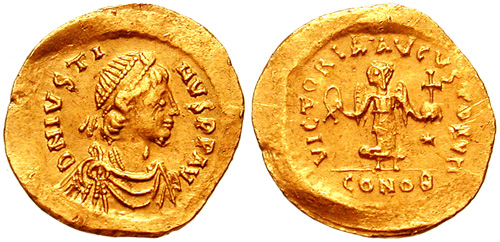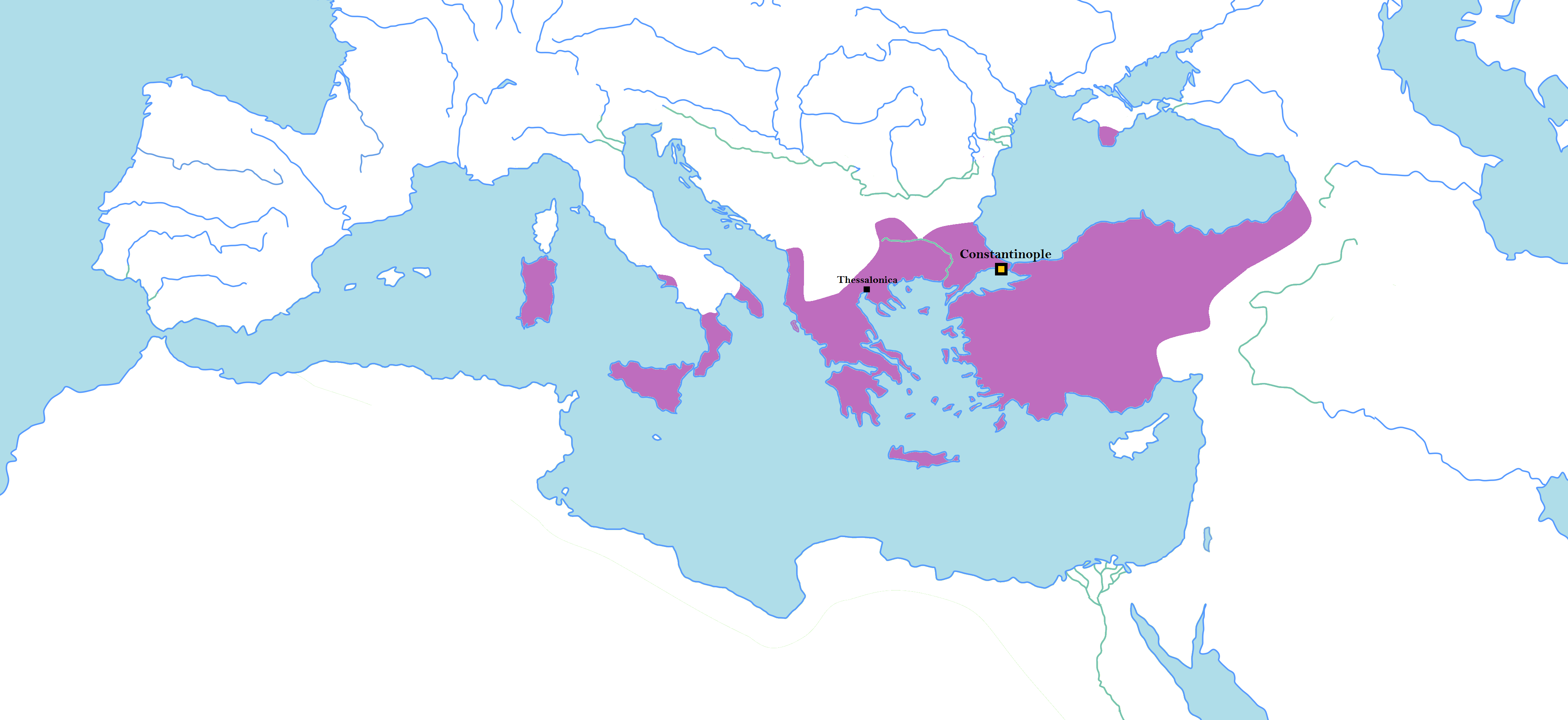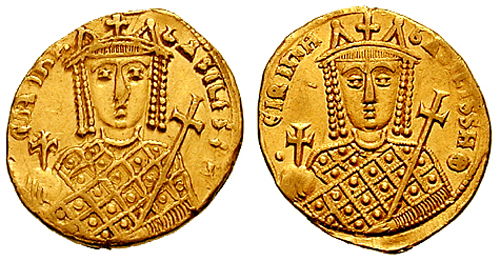|
Michael II The Amorian
Michael II (, ; 770 – 2 October 829), called the Amorian (, ) and the Stammerer (, or , ), reigned as Byzantine emperor from 25 December 820 to his death on 2 October 829, the first ruler of the Amorian dynasty. Born in Amorium, Michael was a soldier, rising to high rank along with his colleague Leo V the Armenian (). He helped Leo overthrow and take the place of Emperor Michael I Rhangabe. However, after they fell out Leo sentenced Michael to death. Michael then masterminded a conspiracy which resulted in Leo's assassination at Christmas in 820. Immediately he faced the long revolt of Thomas the Slav, which almost cost him his throne and was not completely quelled until spring 824. The later years of his reign were marked by two major military disasters that had long-term effects: the beginning of the Muslim conquest of Sicily, and the loss of Crete to Andalusian Arab pirates. Domestically, he supported and strengthened the resumption of official iconoclasm, which had begun ... [...More Info...] [...Related Items...] OR: [Wikipedia] [Google] [Baidu] |
Madrid Skylitzes
The ''Madrid Skylitzes'' is a 12th-century illuminated manuscript version of the ''Synopsis of Histories'' () by John Skylitzes, which covers the reigns of the Byzantine emperors from the death of Nicephorus I in 811 to the deposition of Michael VI Bringas, Michael VI in 1057. The manuscript was produced at the Norman court of Palermo in Sicily (although there is some debate on whether the main body was made in Palermo or Constantinople) and is now housed in the Biblioteca Nacional de España in Madrid. It remains the only preserved Greek-language illustrated chronicle from the Byzantine period. The chronicle includes 574 Miniature (illuminated manuscript), miniatures detailing depictions of everyday life in the Byzantine Empire such as boats, literary practices, sieges, and ceremonies, in "both purely Byzantine illuminated manuscripts, Byzantine and Western styles while also reflecting Islamic miniature, Islamic elements".Helen C. Evans, Evans, Helen C. & Wixom, William D. (1997) ... [...More Info...] [...Related Items...] OR: [Wikipedia] [Google] [Baidu] |
Muslim Conquest Of Sicily
The Arab Muslim conquest of Sicily began in June 827 and lasted until 902, when the last major Byzantine stronghold on the island, Taormina, fell. Isolated fortresses remained in Byzantine hands until 965, but the island was henceforth under Arab Muslim rule until conquered in turn by the Normans in the 11th century. Although Sicily had been raided by the Muslim Arabs since the mid-7th century, these raids did not threaten Byzantine control over the island, which remained a largely peaceful backwater. The opportunity for the Aghlabid emirs of Ifriqiya (present-day Tunisia) came in 827, when the commander of the island's fleet, Euphemius, rose in revolt against the Byzantine Emperor Michael II. Defeated by loyalist forces and driven from the island, Euphemius sought the aid of the Aghlabids, an Arab dynasty. The latter regarded this as an opportunity for expansion and for diverting the energies of their own fractious military establishment and alleviating the criticism of the ... [...More Info...] [...Related Items...] OR: [Wikipedia] [Google] [Baidu] |
Theophobos
Theophobos () or Theophobus, originally Nasir (), Nasr (), or Nusayr (), was a commander of the Khurramites who converted to Christianity and entered Byzantine service under Emperor Theophilos (). Raised to high rank and married into the imperial family, Theophobos was given command of his fellow Khurramites and served under Theophilos in his wars against the Abbasid Caliphate in 837–838. After the Byzantines' defeat at the Battle of Anzen, he was proclaimed emperor by his own men, but did not pursue this claim. Instead he peacefully submitted to Theophilos in the next year and was apparently pardoned, until he was executed by the dying emperor in 842 to prevent a challenge to the accession of Michael III. Biography Theophobos was born to a family originally belonging to the Iranian aristocracy. He was originally a member of the Khurramite sect in western Iran, which was being persecuted by the Abbasid Caliphate. In October/November 833, they were defeated by the armies of Ca ... [...More Info...] [...Related Items...] OR: [Wikipedia] [Google] [Baidu] |
Excubitors
The Excubitors ( or , , i.e. 'sentinels'; transcribed into Greek as , ) were founded in as an imperial guard-unit by the Byzantine emperor Leo I the Thracian. The 300-strong force, originally recruited from among the warlike mountain tribe of the Isaurians, replaced the older as the main imperial bodyguards. The Excubitors remained an active military unit for the next two centuries, although, as imperial bodyguards, they did not often go on campaign. Their commander, the Count of the Excubitors (, ), soon acquired great influence. Justin I was able to use this position to rise to the throne in 518, and thereafter the Counts of the Excubitors were among the main political power-holders of their day; two more, Tiberius II Constantine and Maurice, rose to become emperors in the late 6th century. In the later part of the 7th century the Excubitors appear to have morphed into a parade-ground formation, and they fade from the record as a corps. Individual seals of office suggest ... [...More Info...] [...Related Items...] OR: [Wikipedia] [Google] [Baidu] |
Tagma (military)
The ''tagma'' (; : ''tagmata'', ) is a military unit of battalion or regiment size, especially the elite regiments formed by Byzantine emperor Constantine V and comprising the central army of the Byzantine Empire in the 8th–11th centuries. History and role In its original sense, the term "tagma" (from the Greek ''tássein'', "to set in order") is attested from the 4th century and was used to refer to an infantry battalion of 200–400 men (also termed or in Latin, ''arithmos'' in Greek) in the contemporary East Roman army.Kazhdan (1991), p. 2007 In this sense, the term continues in use in the current Hellenic Armed Forces (''cf.'' Greek military ranks). Imperial guards, 8th–10th centuries In later usage, the term came to refer exclusively to the professional, standing troops, garrisoned in and around the capital of Constantinople.Bury (1911), p. 47 Most of them traced their origins to the Imperial guard units of the late antique Roman Empire. By the 7th century, these ... [...More Info...] [...Related Items...] OR: [Wikipedia] [Google] [Baidu] |
Count Of The Tent
The Count of the Tent (, ''komēs tēs kortēs'') was a Byzantine military-administrative office attested from the 8th to the early 12th centuries. History and functions The title derives from ''korte'', "tent". The emperor often had a Count of the Tent in his own, personal service, the most famous of whom was Michael the Amorian under Nikephoros I (r. 802–811). According to the 10th-century Emperor Constantine VII Porphyrogennetos, during Imperial campaigns through the provinces ( themes), the Imperial Count of the Tent and his subordinates, the ''kortinarioi'', were responsible for pitching the Imperial tent and assisting the Drungary of the Watch in keeping watch over the camp at night... The Count is also attested as an official attached to the staff of a ''strategos'', the military governor of a theme, in seals and documents from the 8th to the early 12th centuries; on seals, the province where he served is often denoted. The office's functions are not clear, but based ... [...More Info...] [...Related Items...] OR: [Wikipedia] [Google] [Baidu] |
Nikephoros I
Nikephoros I (; 750 – 26 July 811), also known as Nicephorus I, was Byzantine emperor from 802 to 811. He was General Logothete (finance minister) under Empress Irene, but later overthrew her to seize the throne for himself. Prior to becoming emperor, he was sometimes referred to as "the Logothete" () and "Genikos" or "Genicus" (), in recognition of his previous role as General Logothete. During his reign, Nikephoros engaged in military campaigns against both the Arabs and the Bulgarians, although the outcomes were varied. While leading an invasion into Bulgaria, he suffered a defeat and was killed at the Battle of Pliska. Background According to several sources outside the Byzantine context, such as Michael the Syrian, al-Tabari, and Mas'udi, there is a tradition that suggests Nikephoros had Ghassanid Arab origins and that he descended from the final Ghassanid ruler Jabala ibn al-Ayham. Al-Tabari assets that he obtained this information from Byzantine sources, althou ... [...More Info...] [...Related Items...] OR: [Wikipedia] [Google] [Baidu] |
Bardanes Tourkos
Bardanes, nicknamed , "the Turk" (, ), was a Byzantine general who launched an unsuccessful rebellion against Emperor Nikephoros I () in 803. Although a major supporter of Byzantine empress Irene of Athens (), soon after her overthrow he was appointed by Nikephoros as commander-in-chief of the Anatolian armies. From this position, he launched a revolt in July 803, probably in opposition to Nikephoros's economic and religious policies. His troops marched towards Constantinople, but failed to win popular support. At this point, some of his major supporters deserted him and, reluctant to engage the loyalist forces in battle, Bardanes gave up and chose to surrender himself. He retired as a monk to a monastery he had founded. There he was blinded, possibly on Nikephoros's orders. Origin and early career Nothing is known of the early life of Bardanes, and his origin is disputed. On account of his first name—a Hellenized form of the common Armenian name Vardan—some scholars consi ... [...More Info...] [...Related Items...] OR: [Wikipedia] [Google] [Baidu] |
Spatharios
The ''spatharii'' or ''spatharioi'' (singular: ; , literally " spatha-bearer") were a class of Late Roman imperial bodyguards in the court in Constantinople in the 5th–6th centuries, later becoming a purely honorary dignity in the Byzantine Empire. History Originally, the term was probably applied to both private and imperial bodyguards.. The original imperial ''spatharioi'' were probably or later became also the eunuch '' cubicularii'' (Greek: ''koubikoularioi''), members of the ''sacrum cubiculum'' (the imperial "sacred chamber") charged with military duties. They are attested from the reign of Emperor Theodosius II (r. 408–450), where the eunuch Chrysaphius held the post. The existence of the specific title of ''spatharokoubikoularios'' for eunuchs in 532 probably suggests the existence by then of other, non-eunuch, ''spatharioi'' in imperial service. The various generals and provincial governors also maintained military attendants called ''spatharioi'', whilst those of t ... [...More Info...] [...Related Items...] OR: [Wikipedia] [Google] [Baidu] |
Athinganoi
The ''Athinganoi'' (, singular ''Athinganos'', , Atsinganoi) were a Manichaean sect regarded as Judaizing heretics who lived in Phrygia and Lycaonia but were neither Hebrews nor gentiles. They kept the Sabbath but were not circumcised. They were '' shomer negiah''. Other sources indicate that the Athinganoi were associated with the Simonians and had no connection to the Manichaean or Paulician sects. They settled in Byzantium in 1054: the year of the East-West Schism. The Athinganoi married Byzantine women, adopted Greek Orthodox Christianity, and eventually assimilated into the Slavic and Greek populations. In some studies, the Athinganoi are described as remnants of the Indo-Greeks who left India in 400 AD during the Migration period. Name The etymology of the word is not certain, but a common determination is a derivation in Greek for "(the) untouchables"derived from a privative alpha prefix and the verb (, , "to touch"). The Manichean sect is mentioned in Soghdian sour ... [...More Info...] [...Related Items...] OR: [Wikipedia] [Google] [Baidu] |
Cappadocian Greeks
The Cappadocian Greeks (; ), or simply Cappadocians, are an ethnic Greek community native to the geographical region of Cappadocia in central-eastern Anatolia; roughly the Nevşehir and Kayseri provinces and their surroundings in modern-day Turkey. There had been a continuous Greek presence in Cappadocia since antiquity, and by at least the 5th century AD the Greek language had become the lingua franca of the region. In the 11th century Seljuq Turks arriving from Central Asia conquered the region, beginning its gradual shift in language and religion. In 1923, following the mass killing of Christian Ottomans across Anatolia, the surviving Cappadocian communities were forced to leave their native homeland and resettle in Greece by the terms of the Greek–Turkish population exchange. Today their descendants can be found throughout Greece and the Greek diaspora worldwide. History Early migrations The area known as Cappadocia today was known to the Ancient Persians as '' ... [...More Info...] [...Related Items...] OR: [Wikipedia] [Google] [Baidu] |




